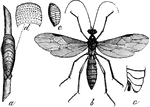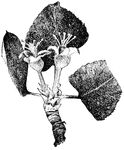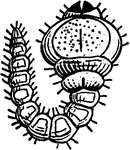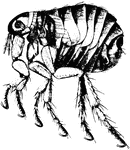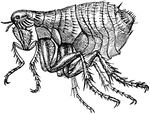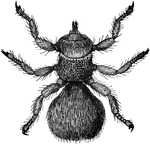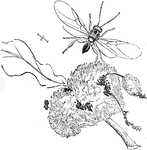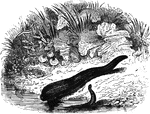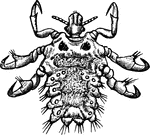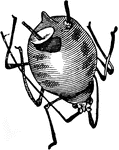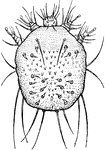
Bladder-Worms
"Diagrams of bladder-worms. I. The ordinary Cysticercus type with one head (H.). II. The Coenurus type,…
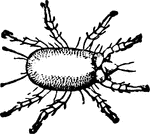
Cheese-mite
"The Cheese-mite, Acarus domesticus, and others are parasitic upon or beneath the skin of man…

Cirolana Microphthalmia
Flabellifera are a type of isopod. Their bodies end in a tail fan, made by the last pair of appendages…
Copepod
Also known as fish lice, this is a species of copepod, a parasitic crustacean. "Female of Chondracathus…

Copepod
Also known as fish lice, this is a species of copepod, a parasitic crustacean. "Female of Chondracathus…

Cordycep
The Sphaeria sinensis a cordycep, a parasitic fungus. "The right hand figure represents the manner in…

Cordycep
The Sphaeria Robertsii a cordycep, a parasitic fungus "growing from the caterpillar of a New Zealand…
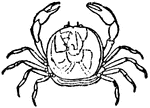
Pea Crab
The pea crab is a small crab in the family Pinnotheridae that lives symbiotically in oysters, clams,…

Entresol
"A low story between two others of greater height, especially one so treated architecturally that from…

Flea
the flea has a curios apparatus for sucking blood, which is very beautiful as examined with a microscope…

Flea
Fleas are parasites. That is any plant or animal which feeds upon another living plant or animal without…

Flea
Fleas are parasites. That is any plant or animal which feeds upon another living plant or animal without…

Human Flea
The human flea (Pulex irritans) is a parasitic insect that actually has several hosts despite its name.

Botfly Larva
"After attaching themselves to the walls of the stomach, the botfly larva are nourished by the blood…
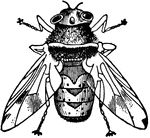
Mature Botfly
"After attaching themselves to the walls of the stomach, the botfly larva are nourished by the blood…
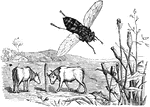
Ox Fly
"The Ox-fly, Oestrus bovis, is three-forths of an inch long, and lays its eggs in the skin of young…

Ruby Tailed Fly
They are rich colored insects, very active in the hottest sunshine and capable of rolling themselves…
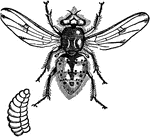
Gadfly of Horse
A gadfly, or Bot-fly, that lays its eggs on horses. After these eggs hatch on the skin, the larvae bore…
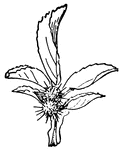
Gall
Galls on leaf of rose. The location of a parasite is often marked by swellings of peculiar and fantastic…
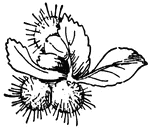
Gall
Galls on leaf of rose. The location of a parasite is often marked by swellings of peculiar and fantastic…
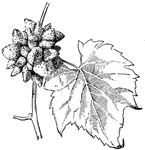
Gall
Galls on stem of grape. The location of a parasite is often marked by swellings of peculiar and fantastic…
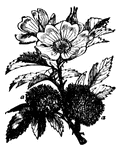
Gall
This spongy gall is found on various species of roses, and is produced by several insects as receptacles…

Gregarina
"Gregarina, contents divided into pseudo-navicellae. GREGARINIDAE. A family or other major group of…
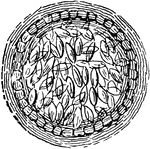
Gregarina
"Gregarina, contents divided into pseudo-navicellae. GREGARINIDAE. A family or other major group of…
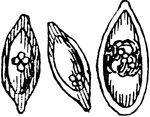
Gregarina
"Gregarina, free pseudo-navicellae. GREGARINIDAE. A family or other major group of endoplastic protozoans,…
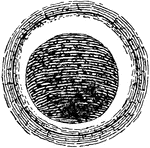
Gregarina Encysted
"Gregarina of Earthworm, encysted. GREGARINIDAE. A family or other major group of endoplastic protozoans,…
Gregarina of Earthworm
"Gregarina of Earthworm. GREGARINIDAE. A family or other major group of endoplastic protozoans, having…

Amoebiform Gregarina
"Gregarina, their free amoebiform contents. GREGARINIDAE. A family or other major group of endoplastic…
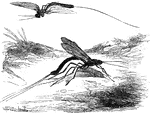
Ichneumon
"The ichineumons, with long ovipositors, as the European species, Ichneumon manifestator, seek…

Ichneumon Fly
Ichneumon flies are solitary insects, and most are parasitoids—the larvae feeding on or in another…
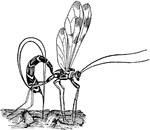
Ichneumon Fly
Ichneumon flies are solitary insects, and most are parasitoids—the larvae feeding on or in another…

Ichneumon Fly
Ichneumon flies deposit their eggs upon the bodies of other insects and larva. The larva live on the…
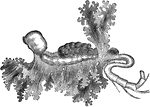
Parasitic Isopod
Entoniscus parasites is a parasitic isopod that feeds off and eventually replaces the tongues of fish…
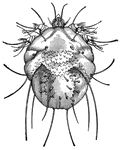
Head Louse
Head lice are parasites. That is any plant or animal which feeds upon another living plant or animal…

Magnified Louse
"A genus of insects, the type of a very numerous family, which forms the order Parasita or Auoplura.…
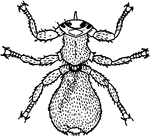
Sheep Louse
"A common dipterous insect, which feeds upon the blood of sheep and lambs."—Finley, 1917

Medicinal Leech
The medicinal leech is a leech used in bloodletting. It lives in fresh water, and is common in Germany,…

Mistletoe
"A genus of small parasitical shrubs of the natural order Loranthaceae. This order is exogenous, and…
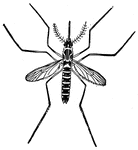
Mosquito
Mosquitos are parasitic insects that suck blood from humans and other mammals. They are known to spread…
Nematode
"Diagram of the structure of a male Nematode. M., mouth; OE., oesophogus; GA., nerve ring; B., bulb…
Nemertea
"Diagrammatic longitudinal section of a Nemertean (Amphiporum lactifloreus), dorsal view. p.p., Proboscis…
